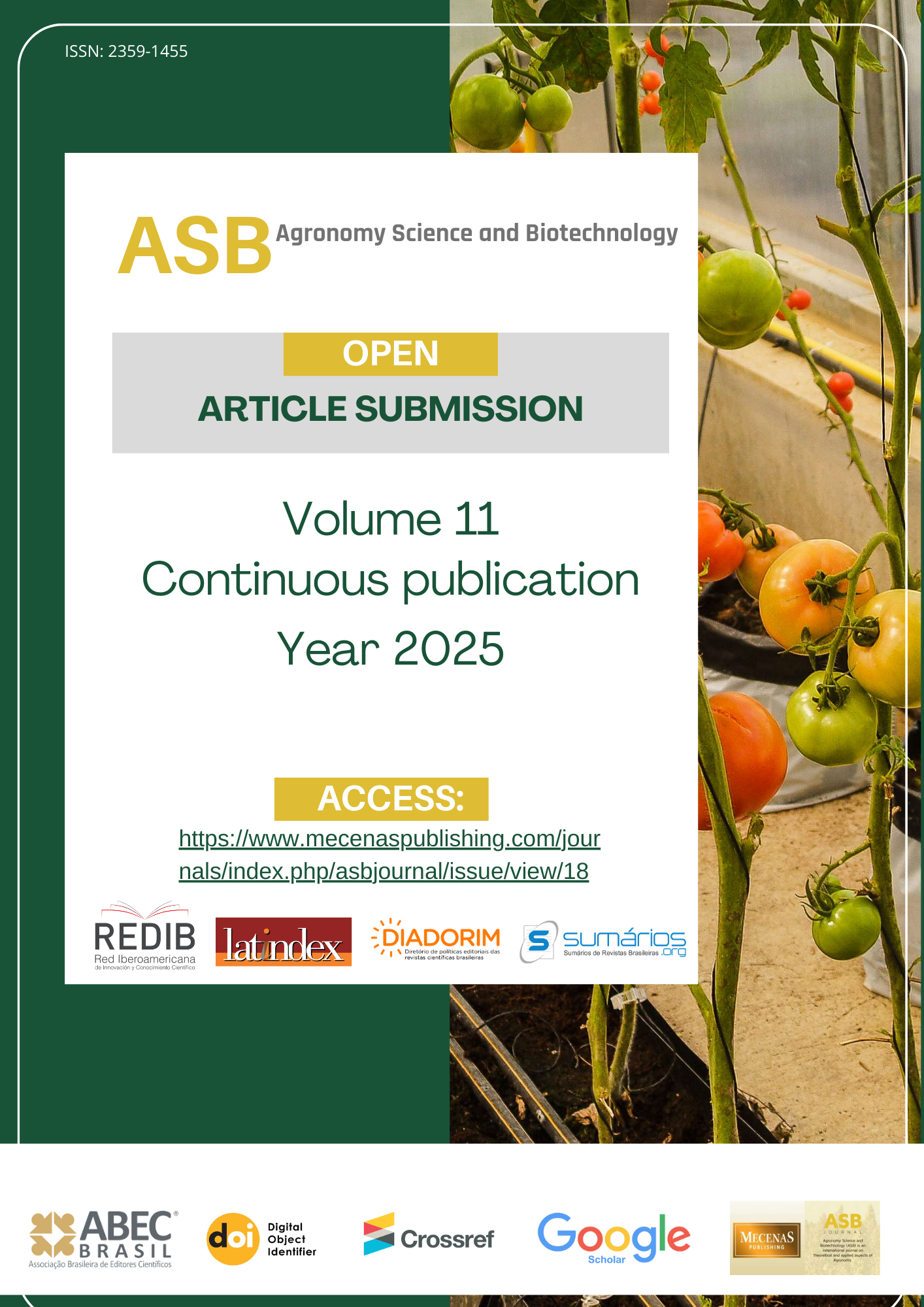Interaction between arbuscular mycorrhizal fungi and biofertilizer in cotton crops
Resumo
The use of biofertilizers and biological solutions to meet the nutritional needs of plants has grown significantly in agriculture as a way to replace mineral fertilizers, which in turn contribute to increasing the production costs for farmers. Therefore, it is essential to conduct studies to prove the effectiveness of these methods and assist producers in their decision-making. The objective of this study was to evaluate the effect of seed treatment with biofertilizer and inoculation with Rhizophagus clarus on cotton growth. The experiment was carried out in an experimental area in Rolândia-PR in a randomized block experimental design, with four treatments and four replicates: T1: (T) control (not inoculated), T2: (M) mycorrhiza (Rhizophagus clarus), T3: (B) biofertilizer of plant extracts of Aloe vera (Aloe solo) and T4: (M+B) mycorrhiza + Aloe solo. Cotton seeds of cultivar TMG 81 were treated according to the treatments described above. Sowing was carried out with 12 plants per linear meter with spacing of 90 cm between rows. Chemical management practices were carried out to control weeds and pests. Chemical fertilization was carried out at sowing in the furrow, where 310 kg per hectare of the formula 12-17-11 and 90 kg of calcium carbonate per hectare were deposited. Top dressing fertilization was applied 25 days after sowing with 125 kg ha-1 of NPK formula in the proportion 20-05-20, 63 kg ha-1 of urea and 75 kg ha-1 of potassium chloride, in addition to 0.625 L ha-1 of Boron 10 via foliar application. Plants from two 2-meter rows of each plot were evaluated for the following parameters: yield, plant height, number of open and closed bolls and nos per plant. Leaves were collected at the time of full flowering for leaf analysis. Data were analyzed using Tukey's test at 5%. The combined treatment of biofertilizer and mycorrhiza showed the best results, with a significant increase in all production components, including an increase of 525 kg per hectare compared to the control. Inoculation with mycorrhizal fungi and the application of biofertilizers contributed to higher yield and vegetative parameters of cotton.
Downloads
Referências
Abdulla, D. O., & Karademir, C. (2019). The Effect of Biofertilizers on Cotton (Gossypium hirsutum L.) Development Yield and Fiber Technological Properties. Global Journal Of Botanical Science, 7, 1–9. https://doi.org/10.12974/2311-858X.2019.07.1
ABRAPA - Associação Brasileira dos Produtores de Algodão. 2021. https://www.abrapa.com.br. Accessed on Oct 11, 2024.
Arif, M., Kareem, S. H. S., Ahmad, N. S., Hussain, N., Yasmeen, A., Anwar, A., Naz, S., Iqbal, J., Shah, G. A., & Ansar, M. (2019). Exogenously Applied Bio-Stimulant and Synthetic Fertilizers to Improve the Growth, Yield and Fiber Quality of Cotton. Sustainability, 11(7), 2171. https://doi.org/10.3390/su11072171
Arya, A., & Buch, H. 2013. Response of arbuscular mycorrhizal fungi on growth and chlorophyll content of three varieties of Gossypium herbaceum L. Plant Pathol Quarantine, 3:54–57. Doi 10.5943/ppq/3/1/8
Banzatto, D. A., & Kronka, S. N. (2008). Experimentação agrícola. (3rd ed.). Jaboticabal, SP: Funep.
Cely, M. V. T., Oliveira, A. G., Freitas, V.F., Luca, M. B., Barazetti, A. R., Santos, I. M. O., Gionco, B., Garcia, G. V., Prete, C. E. C, & Andrade, G. (2016). Inoculant of arbuscular mycorrhizal fungi (Rhizophagus clarus) increase yield of soybean and cotton under field conditions. Frontiers Microbiology, 7:720. https://doi.org/10.3389/fmicb.2016.00720
CONAB – Companhia Nacional de Abastecimento. Indicadores da agropecuária. 2025. Algodo_Conjuntura_Semanal_-_03-03-2025_a_07-03-2025.pdf. Accessed on March 17, 2025.
Gao, X., Guo, H., Zhang, Q. et al. 2020. Arbuscular mycorrhizal fungi (AMF) enhanced the growth, yield, fiber quality and phosphorus regulation in upland cotton (Gossypium hirsutum L.). Scientific Report, 10, Article number 2084. https://doi.org/10.1038/s41598-020-59180-3
Khater, R, M., Abd-Allah, W. H., & Shafay, R. M. M. (2020). Effect of organic fertilization and spraying Aloe vera extract on the growth and productivity of Carum carvi L. plant under Shalateen conditions in Egypt. Plant Archives, 20 (2): 4959-4971.
Laishram, B., Devi, O. R., Dutta, R., Senthilkumar, T., Goyal, G., Paliwal, D. K., Panotra, N., & Rasool, A. 2025. Plant-microbe interactions: PGPM as microbial inoculants/ biofertilizers for sustaining crop productivity and soil fertility, Current Research in Microbial Sciences, 8 100333. https://doi.org/10.1016/j.crmicr.2024.100333
Leoni, B., Loconsole, D., Cristiano, G., & Lucia, B. (2019). Comparison between chemical fertilization and integrated nutrient management: yield, quality, N, and P contents in dendranthema grandiflorum (Ramat.) kitam. Cultivars. MDPI - Agronomy, 9(4), 202. https://doi.org/10.3390/agronomy9040202
Moosavi, S. G. 2019. Effect of mycorrhiza and humic acid application on physiological traits, yield and water use efficiency of cotton under water deficit stress conditions. Journal of Crops Improvement, 22, 43–55. (In Persian). https://doi.org/10.22059/jci.2019.282993.2228
Moreira, F. M. S., & Siqueira, J. O. 2006. Microbiologia e bioquímica do solo. v. 2. Lavras, MG: Universidade Federal de Lavras.
R Core Team. (2024). R: A Language and Environment for Statistical Computing. R Foundation for Statistical Computing. https://www.R-project.org/
Salgado, F. H. M., Sousa, M. F. M., Siqueira, J. O., Barbosa, R. H., Paulino, H. B., & Carneiro, M. A. C. 2017. Arbuscular mycorrhizal fungi and colonization stimulant in cotton and maize. Ciência Rural, 47(6), e20151535. https://doi.org/10.1590/0103-8478cr20151535
Santos, H. G., Jacomine, P. T., Anjos, L. H. C., Oliveira, V. Á., Lumbreras, J. F., Coelho, M. R., & Cunha, T. J. F. 2018. Brazilian Soil Classification System.Embrapa Solos. Livro técnico, Infoteca. Rio de Janeiro, Embrapa Solos.
Copyright (c) 2025 ASB Journal

This work is licensed under a Creative Commons Attribution 4.0 International License.










